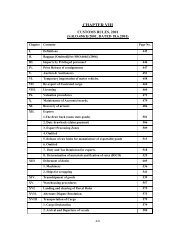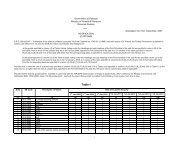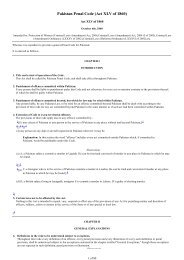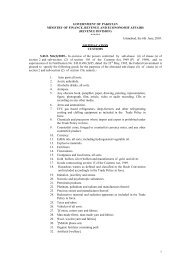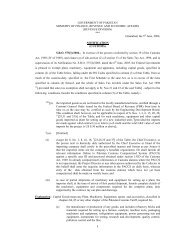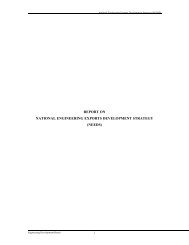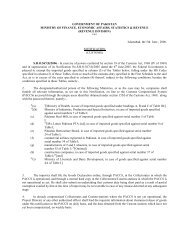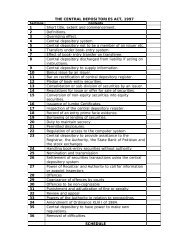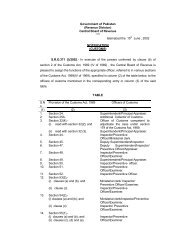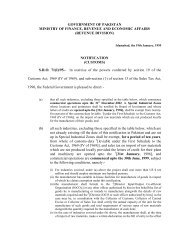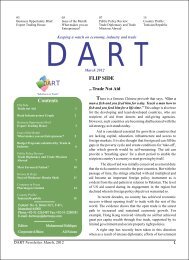47. Pakistan Economic Survey 2011-12 - Consultancy Services in ...
47. Pakistan Economic Survey 2011-12 - Consultancy Services in ...
47. Pakistan Economic Survey 2011-12 - Consultancy Services in ...
You also want an ePaper? Increase the reach of your titles
YUMPU automatically turns print PDFs into web optimized ePapers that Google loves.
<strong>Pakistan</strong> <strong>Economic</strong> <strong>Survey</strong> <strong>2011</strong>-<strong>12</strong>TSS 1.2 to 6.2 times higher than surface waterguidel<strong>in</strong>es.Globally, improved sanitation coverage was justabove the 60 percent mark <strong>in</strong> 2008, up from 54percent <strong>in</strong> 1990, with over 2,500 million peoplestill without access. Half of the people liv<strong>in</strong>g <strong>in</strong>develop<strong>in</strong>g regions have no access to improvedsanitation 1 .Municipal sewage is a major source of surfacewater pollution. About 2 million wet tons ofhuman excreta are annually produced <strong>in</strong> the urbansector of which around 50 percent go onto pollutewater bodies. The National Conservation Strategystates that almost 40 percent of all disease relateddeaths are connected to water borne diseases.Other sources of water pollution are <strong>in</strong>dustrialeffluents, solid waste, hospital waste, chemicalfertilizers and pesticides.In <strong>Pakistan</strong> sanitation facilities are improv<strong>in</strong>g.However, much improvement is needed for ruralareas sanitation facilities. Accord<strong>in</strong>g to PBS<strong>Pakistan</strong> Standard Liv<strong>in</strong>g Measurement 2008-09,14 percent of all garbage collection facilitiesprovided to the population are executed throughmunicipalities, 7 percent through privatelymanaged collection systems, and the rema<strong>in</strong><strong>in</strong>g 79percent have no system.The most basic requirement for proper sanitation issafe disposal of excreta away from a dwell<strong>in</strong>g unit,by us<strong>in</strong>g a sanitary latr<strong>in</strong>e. There is a greatvariation <strong>in</strong> latr<strong>in</strong>e coverage between prov<strong>in</strong>ces.Urban S<strong>in</strong>dh has the best coverage followed byurban Khyber Pakhtukhwa.In most of the urban and rural population water issupplied from the ground water except for thecities of Karachi, Hyderabad, and part ofIslamabad, which ma<strong>in</strong>ly uses surface water.Therefore, deteriorat<strong>in</strong>g ground water quality <strong>in</strong><strong>Pakistan</strong> has serious implications for theenvironment and health of <strong>Pakistan</strong>’s population.Different national and <strong>in</strong>ternational reports haveidentified <strong>Pakistan</strong> as one of the most ‘waterstressed’ countries <strong>in</strong> the world, fac<strong>in</strong>g lack of1 UN-<strong>2011</strong>water availability for irrigation, <strong>in</strong>dustry andhuman consumption. Accord<strong>in</strong>g to a World Bankreport, water supply <strong>in</strong> <strong>Pakistan</strong> fell from 5000cubic meters to 1000 cubic meters <strong>in</strong> 2010, and islikely to further reduce to 800 cubic meters percapita by 2020 due to grow<strong>in</strong>g population pressure,rapid urbanization and <strong>in</strong>dustrialization.The government is committed to provide safedr<strong>in</strong>k<strong>in</strong>g water through clean dr<strong>in</strong>k<strong>in</strong>g water<strong>in</strong>itiatives and <strong>in</strong>stallation of water filtration plants.However, the execution and monitor<strong>in</strong>g ofgovernment efforts are be<strong>in</strong>g h<strong>in</strong>dered by limitedresources, <strong>in</strong>creas<strong>in</strong>g population, fast grow<strong>in</strong>gurban development, <strong>in</strong>dustrialization, highoperational and ma<strong>in</strong>tenance and poor costrecovery, lack of private sector participation, andlow <strong>in</strong>stitutional capacities.Strategy and Action Plans (Water & Sanitation) Develop legal and policy frameworksregard<strong>in</strong>g promotion of safe dr<strong>in</strong>k<strong>in</strong>g water <strong>in</strong><strong>Pakistan</strong>. This promotion would <strong>in</strong>cludedesal<strong>in</strong>ization of sea water. Develop a water quality database to assist <strong>in</strong>decision mak<strong>in</strong>g. Establish a water quality monitor<strong>in</strong>g andsurveillance system based on enforceablewater quality guidel<strong>in</strong>es and standards.Conduct cyclic 4 seasonal water qualitymonitor<strong>in</strong>g for major rivers and waterreservoirs. Address arsenic pollution of groundwater <strong>in</strong>S<strong>in</strong>dh and Punjab through specific <strong>in</strong>itiatives<strong>in</strong>clud<strong>in</strong>g <strong>in</strong>vestigative studies and awarenessrais<strong>in</strong>g programmes. Develop legal and policy frameworksregard<strong>in</strong>g promotion of safe dr<strong>in</strong>k<strong>in</strong>g water <strong>in</strong><strong>Pakistan</strong>. Make <strong>in</strong>stallation of water treatment plants an<strong>in</strong>tegral component of dr<strong>in</strong>k<strong>in</strong>g water supplyschemes. Develop an <strong>in</strong>tegrated approach that will guidethe allocation of water, allocation of<strong>in</strong>vestment and pric<strong>in</strong>g of water services, both<strong>in</strong> rural and urban areas.Comment [MM9]: How did access to waterrema<strong>in</strong> at 90-95% with this precipitous drop <strong>in</strong>availability?Comment [MM10]: don't capitalize unless that'sthe name of the <strong>in</strong>itiative.Comment [MM6]: tonnes, right?Comment [MM7]: 40 percent of disease relateddeaths, right?Comment [MM8]: This head<strong>in</strong>g also talks aboutdr<strong>in</strong>k<strong>in</strong>g water, while the previous section also talksabout sanitation. Makes sense to comb<strong>in</strong>e <strong>in</strong>to onesub-head<strong>in</strong>g?242



